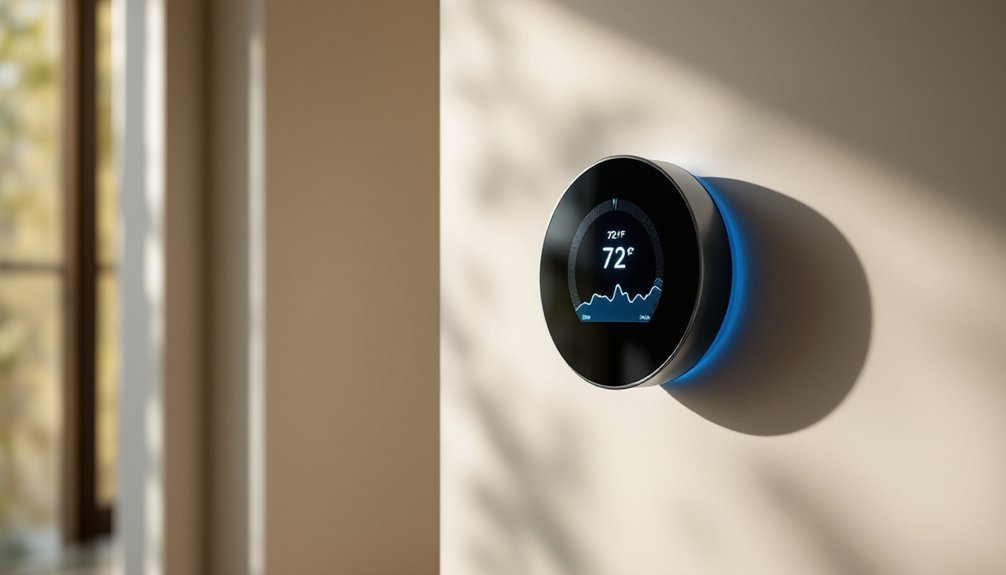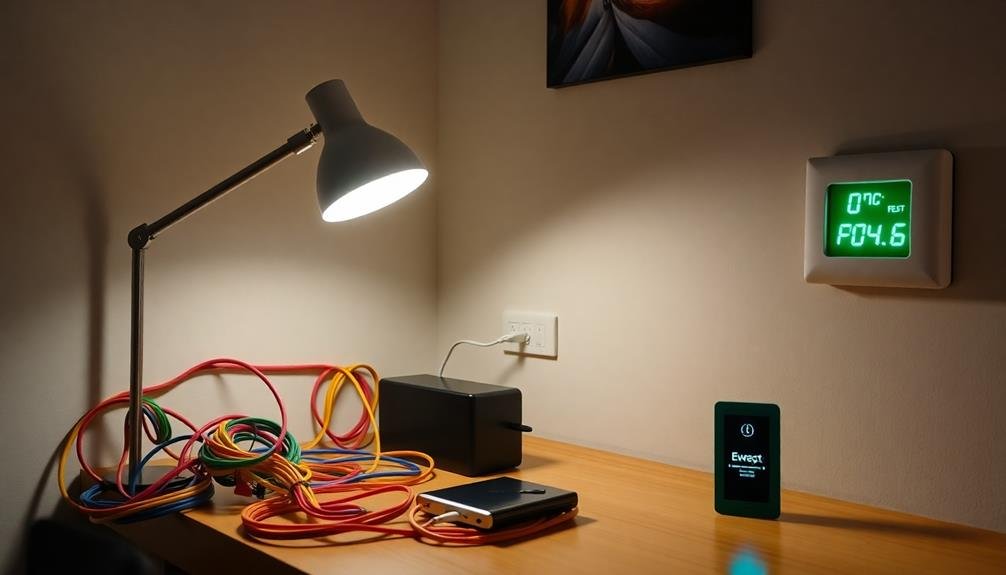You're about to discover how the latest smart thermostats can slash your energy bills in 2025. While many devices claim to save you money, only a select few deliver meaningful returns on your investment. From AI-powered learning capabilities to advanced occupancy detection, these seven thermostats offer proven solutions for cost-conscious homeowners. Let's explore which models are worth your attention and how they'll transform your home's energy efficiency this year.
Google Nest Smart Thermostat (Charcoal)
For homeowners seeking significant energy savings without sacrificing convenience, the Google Nest Smart Thermostat in Charcoal delivers an impressive combination of automation and control. You'll appreciate its sleek design, measuring just 3.3 inches wide with a crisp 2-inch LCD display.
The thermostat's intelligent features automatically adjust temperatures when you're away and suggest energy-saving tweaks through its Savings Finder. You can control it remotely via the Google Home app or voice commands through Google Assistant and Alexa. While DIY installation typically takes 30 minutes, you'll want to verify your system's compatibility first, as some homes require a C-wire adapter for proper functioning.
Best For: Homeowners looking to modernize their HVAC system with a smart, energy-efficient thermostat that offers remote control capabilities and automatic temperature adjustments.
Pros:
- Energy-saving features like automatic temperature adjustments and optimization suggestions can lead to lower utility bills
- Easy remote control through smartphone app and voice commands with Google Assistant or Alexa integration
- Sleek, modern design with an intuitive interface and clear LCD display
Cons:
- Some homes require additional C-wire installation or adapter, which adds complexity and cost
- Cannot support both 2-stage heating and cooling simultaneously
- Installation process may be challenging for those unfamiliar with HVAC wiring
Mysa Smart Thermostat LITE for Electric Baseboard Heaters
Owners of electric baseboard heaters can rejoice with the Mysa Smart Thermostat LITE, a specialized 240V solution that fills an essential gap in the smart thermostat market. It's compatible with electric baseboards and fan-forced heaters, requiring just four wires for installation.
You'll appreciate its sleek polycarbonate design and user-friendly LED display. The free app lets you control temperatures remotely, while integration with HomeKit, Alexa, and Google Home enables voice commands. You can create custom schedules to optimize energy usage, potentially saving up to 26% on heating costs. With expert support from certified electricians and detailed video tutorials, installation is straightforward, though some users report occasional Wi-Fi connectivity issues.
Best For: Homeowners with electric baseboard or fan-forced heaters seeking a smart solution to reduce energy costs while gaining remote control and automation capabilities.
Pros:
- Easy DIY installation with comprehensive video tutorials and expert support
- Integrates seamlessly with major smart home platforms (HomeKit, Alexa, Google Home)
- Potential for significant energy savings (up to 26%) through smart scheduling and remote control
Cons:
- Some users report Wi-Fi connectivity issues
- Requires specific wiring setup (minimum four wires including neutral)
- Limited to high/line voltage electric heating systems only (not compatible with other heating types)
ecobee3 Lite Smart WiFi Thermostat
Budget-conscious homeowners seeking substantial energy savings will appreciate the ecobee3 Lite Smart WiFi Thermostat's ability to cut heating and cooling costs by up to 23% annually. This sleek device works seamlessly with most 24VAC HVAC systems and integrates with Siri, Alexa, and Google Assistant for convenient voice control.
You'll love controlling your home's temperature from anywhere using the intuitive mobile app. The DIY installation takes about 15 minutes, with step-by-step guidance based on your existing wiring. Add SmartSensors to manage hot and cold spots while automatically pausing heating and cooling when doors or windows are open.
Best For: Budget-conscious homeowners who want smart temperature control with significant energy savings potential and integration with major voice assistants.
Pros:
- Potential for substantial energy savings (up to 23% annually on heating/cooling costs)
- Easy DIY installation with helpful app guidance and support
- Versatile compatibility with most HVAC systems and popular voice assistants
Cons:
- SmartSensor must be purchased separately for full functionality
- Limited to 2.4GHz Wi-Fi networks only
- Some advanced features require additional equipment or sensors
Smart Thermostat with WiFi and Voice Control
People seeking thorough control over their home's climate will appreciate the BHP-8000n Smart Thermostat's versatile management options. You'll get voice commands, touch buttons, and app control through the Smart Life platform, making temperature adjustments effortless from anywhere.
While the thermostat promises 25% savings on heating and cooling costs, its 3.0-star rating suggests mixed user experiences. Installation takes under 30 minutes, but you'll need a special screwdriver and C-wire adapter. The device works with 95% of HVAC systems but isn't compatible with heating-only or high-voltage setups. Six touch buttons enable quick mode switching, and the programmable scheduling feature automates temperature changes based on your routine.
Best For: Homeowners seeking a DIY smart thermostat solution with multiple control options and automated scheduling capabilities who have compatible HVAC systems with C-wire availability.
Pros:
- Multiple control options including voice commands, touch buttons, and mobile app access
- Potential for significant energy savings (25% reduction in heating/cooling costs)
- Quick 30-minute DIY installation with included C-wire adapter
Cons:
- Limited compatibility (not suitable for heating-only or high-voltage systems)
- Requires special screwdriver for installation (not included)
- Mixed user reviews with relatively low 3.0-star rating
Google Nest Learning Thermostat (4th Gen) with Temperature Sensor
Smart home enthusiasts seeking substantial energy savings will find the Google Nest Learning Thermostat (4th Gen) an impressive investment. You'll appreciate its 60% larger display and sleek Polished Obsidian finish that enhances any room's decor.
The thermostat learns your preferences and automatically adjusts temperatures, helping you save up to 12% on heating and 15% on cooling bills. With the included Nest Temperature Sensor, you can maintain precise comfort in specific rooms. The device works seamlessly with most 24V systems and integrates with Alexa and Google Home for convenient voice control. Installation is straightforward, and you'll quickly master the user-friendly interface through the Google Home app.
Best For: Homeowners looking to reduce energy costs while maintaining precise temperature control through a smart, learning-enabled system that can be controlled remotely.
Pros:
- Impressive energy savings with automatic learning capabilities that can reduce heating bills by 12% and cooling bills by 15%
- Enhanced visibility with 60% larger display and included temperature sensor for precise room-by-room control
- Easy installation and compatibility with most 24V systems, plus seamless integration with popular voice assistants
Cons:
- Higher initial cost compared to traditional thermostats
- Some users report challenges with screw length during installation
- May require additional learning curve to fully utilize all features through the Google Home app
Sensi Smart Thermostat, Wi-Fi & Alexa Compatible
Do-it-yourself homeowners who value simplicity will appreciate the Sensi Smart Thermostat's straightforward approach to energy management. This ENERGY STAR certified device can help you slash HVAC costs by 23% through its flexible scheduling and remote access features.
You'll find installation a breeze with the built-in level and step-by-step app guidance, and in most cases, you won't need a c-wire. The 5-inch LED display and button controls offer easy operation, while voice commands work seamlessly with Alexa and Google Assistant. Your privacy stays protected, as Sensi doesn't sell personal data to third parties. With over 21,000 positive reviews, this reliable thermostat delivers on its promises.
Best For: Budget-conscious DIY homeowners looking for a simple, reliable smart thermostat with basic scheduling features and voice control capabilities.
Pros:
- Easy DIY installation with built-in level and step-by-step app guidance
- Significant energy savings potential (up to 23%) through flexible scheduling and remote access
- Strong compatibility with major voice assistants (Alexa, Google Assistant) and reliable Wi-Fi connectivity
Cons:
- Limited daily usage report details compared to premium smart thermostats
- Occasional issues with setting adjustments
- No compatibility with Samsung's Bixby voice assistant
Amazon Smart Thermostat, Works with Alexa
The affordable Amazon Smart Thermostat stands out as an excellent choice for Alexa users who want to reduce their energy bills without breaking the bank. You'll save an average of $50 annually with this ENERGY STAR certified device, and you might qualify for additional rebates from your local energy provider.
The thermostat learns your patterns through Alexa Hunches, automatically adjusting temperatures when you're home, away, or sleeping. While you'll need a C-wire or power adapter for installation, the setup process is straightforward through the Alexa app. You can control temperatures via voice commands, the app, or directly on the device, though some users report connectivity issues after power outages.
Best For: Budget-conscious Alexa users seeking an affordable smart thermostat that offers energy savings and basic smart home integration.
Pros:
- Significantly more affordable than competing smart thermostats while offering essential features
- ENERGY STAR certified with potential for substantial energy savings and local rebates
- Easy setup and intuitive control through Alexa app, voice commands, or manual adjustment
Cons:
- Requires C-wire or separate power adapter purchase for installation
- Some users report connectivity issues after power outages
- More basic scheduling capabilities compared to premium competitors
Factors to Consider When Choosing Smart Thermostats for Energy-Efficient Homes in 2025
When you're selecting a smart thermostat for your energy-efficient home in 2025, you'll want to assess each model's potential energy savings and integration capabilities with your existing smart home ecosystem. You'll need to verify your HVAC system's compatibility and evaluate the installation requirements, which may involve C-wire availability or professional setup. The ability to control your thermostat remotely through mobile apps and voice commands should also factor into your decision, as these features can considerably impact both convenience and energy optimization.
Energy Savings Potential
Modern smart thermostats offer significant energy-saving potential, with most homeowners seeing a 10-25% reduction in their heating and cooling expenses. You'll benefit from features like adaptive scheduling and remote temperature control, which optimize your HVAC system's performance throughout the day.
These devices monitor your system's health and alert you when maintenance is needed, helping prevent expensive repairs while maintaining peak efficiency. The built-in occupancy detection automatically adjusts temperatures based on whether you're home, eliminating wasteful heating and cooling of empty spaces. You can also set specific temperature goals for different times, ensuring comfort when you need it and savings when you don't. Don't forget to check with your local energy provider – you might qualify for rebates that make your smart thermostat investment even more worthwhile.
Smart Home Integration Capabilities
Smart home integration takes your energy-saving potential to new heights in 2025's connected ecosystem. You'll benefit from seamless voice control through popular assistants like Google Assistant, Alexa, and Apple HomeKit, letting you adjust your climate settings effortlessly.
Mobile app connectivity means you're always in control of your home's temperature, whether you're at work or on vacation. Your smart thermostat can work alongside other devices in your home, automatically adjusting temperatures when security systems detect you've left or when motion sensors indicate room occupancy. You'll also gain access to utility company programs that provide real-time energy consumption data and money-saving opportunities through demand response initiatives. For maximum efficiency, consider models that connect with additional sensors to fine-tune temperature adjustments based on actual room conditions.
Installation Requirements
Before selecting your ideal smart thermostat, understanding installation requirements will guarantee a smooth changeover to energy-efficient climate control. You'll need to verify your home's wiring setup, particularly whether you have a C-wire, as this determines which models are compatible with your system.
While most smart thermostats are designed for DIY installation with 30-minute setup times, you'll want to gather basic tools like screwdrivers beforehand. Check manufacturer compatibility tools online to confirm your HVAC system works with your chosen model. Don't skip the included step-by-step guides or video tutorials, as proper wiring connections are essential for both functionality and safety. If you're not comfortable with electrical work, manufacturers offer customer support and documentation to help you through the process or guide you to professional installation services.
Remote Control Features
As homeowners increasingly prioritize energy efficiency, remote control capabilities have become a cornerstone feature of today's leading smart thermostats. You'll appreciate the flexibility to adjust your home's temperature from anywhere using intuitive mobile apps, ensuring comfort while optimizing energy use.
Voice assistant compatibility lets you control your thermostat hands-free, making adjustments as simple as saying a command. You can integrate these devices with your existing smart home setup to create automated temperature schedules based on your daily routines and occupancy patterns.
The real-time energy monitoring feature in your mobile app helps you track consumption patterns and make informed decisions about your heating and cooling habits. You'll find customizable settings that let you create personalized schedules, ultimately leading to noticeable savings on your energy bills.
HVAC System Compatibility
While remote control features enhance your smart thermostat's functionality, selecting a device that matches your home's HVAC system specifications remains the foundation of successful installation. Before purchasing, you'll need to verify your system's voltage – most smart thermostats work with 24V systems, but if you've got electric baseboards, you'll need a high-voltage compatible model.
Don't forget to check if your system has a C wire, which many smart thermostats require for power and wireless connectivity. If you're missing this essential component, you might need to install an adapter or additional wiring. Also, confirm that your chosen thermostat can handle specific heating types like heat pumps or multi-stage systems. Use manufacturers' compatibility checkers to ascertain your selection works with both your HVAC system and preferred smart home ecosystem.
Power Source Options
Selecting the right power source for your smart thermostat greatly impacts its long-term performance and reliability. You'll need to choose between battery-powered and hardwired options, each with distinct advantages for your home setup.
If you're looking for consistent performance, corded electric models connected to 24V HVAC systems offer the most stable operation. They'll eliminate the hassle of battery replacements and reduce the risk of connectivity disruptions. For homes without a C-wire, you'll find smart thermostats with power adapters or specialized features that can work with existing wiring.
When evaluating power options, consider your home's current wiring configuration and energy efficiency goals. Battery-powered units provide flexibility but require regular maintenance, while hardwired models typically deliver more reliable energy management and potential cost savings on your utility bills.
Frequently Asked Questions
How Long Does a Smart Thermostat's Battery Typically Last?
You'll typically get 1-2 years from your smart thermostat's battery, but this varies based on usage and model. Some run on your HVAC system's power, while others need AA or AAA batteries replaced periodically.
Can Smart Thermostats Work During Internet Outages?
Yes, your smart thermostat will still control your home's temperature during internet outages. While you won't have remote access or advanced features, it'll continue working with its basic heating and cooling functions like a regular thermostat.
Do Smart Thermostats Require Professional Installation?
While you can install most smart thermostats yourself with basic DIY skills, you'll want professional help if you're not comfortable with wiring or have a complex HVAC system. Many brands offer installation services.
Are Smart Thermostats Compatible With All HVAC Systems?
No, your smart thermostat won't work with every HVAC system. You'll need to check compatibility before buying. Most work with 24V systems, but they may not support line voltage, millivolt, or proprietary systems.
How Much Electricity Do Smart Thermostats Consume Themselves?
Your smart thermostat typically uses very little power, around 1-2 watts when active and 0.5 watts in standby mode. That's about $1-2 per year in electricity costs, making it negligible compared to your savings.





Leave a Reply